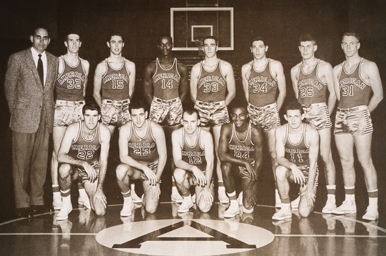
It’s hard to know what Coach David Carrasco Sr. was thinking as he stood over the swimming pool in February 1958 watching his AU men’s basketball team celebrate a huge 55–75 Mason-Dixon Conference victory on the road in Ashland, Virginia, against Randolph-Macon College.
But one thing is certain: After a hotly contested game in an unwelcoming environment, the Yellow Jackets’ athletic director was not happy to discover Black, White, and Jewish AU players splashing around together in the segregated South.
“What are you going to do about this?” he yelled at Carrasco. “You’ve got to get these guys out of here.”
“Don’t worry, we’ll get out—just as soon as I do this,” Carrasco said before jumping into the pool himself.
Longtime NBA executive Ed Tapscott, WCL/JD ’80, shared the story he’d heard secondhand from Wil Jones, CAS/BA ’64, one of the Black players on the AU squad, which integrated DC college basketball in 1956—nearly a decade before any other area university—during a February 3 event at the Washington College of Law.
“This gave me a sense of the moment and the special team bonds that were forged with this group,” said Tapscott, who became AU’s first Black head coach in 1982. “This story is important to this institution and to the District of Columbia.”
Carrasco, the first Mexican American head coach for a major US men’s hoops program, hadn’t been on the job long when in 1956 he told then AU president Hurst Anderson that he wanted to integrate the basketball team. Anderson agreed.
Soon after, Carrasco recruited local player Dickie Wells, CAS/BA ’65, who officially broke the color barrier in the DC area when he started at center in AU’s season opener at the Naval Academy on December 5, 1956. Jones joined the team later that season.
Those teams were not only changemakers, but champions too. After Carrasco’s first Eagles squad went 10–14 in the 1956–57 season, the program won 66 games, three Mason-Dixon Conference titles, and made three trips to the NCAA College Division tournament between 1957 and 1959. For his part, Carrasco was named the 1958 college-division national coach of the year.
Carrasco grew up in the El Segundo Barrio, a dangerous neighborhood located near the border in El Paso, Texas. He was a street fighter and talented basketball player in his own right before enlisting in the Navy.
After he was commissioned, Carrasco moved to Naval Training Center Bainbridge in Maryland to train African American midshipmen. As a person of color himself, that experience helped inform how he connected with the families of his Black players, convincing recruits that he would take care of them. The rest is history.
“They saw that this man shared their world,” said Harvard professor David Carrasco Jr. of his late father. “It’s important to understand that’s what you needed at that time, for this to take place at AU.”